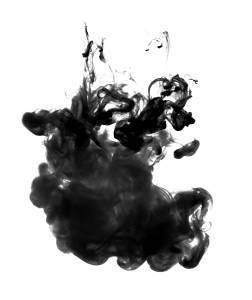
 Not only are there hundreds of shades of black, but industrial inkjet ink manufacturers can control other properties of the black ink down to a molecular level. Adhesion, longevity, and decap time play a role in formulating a black ink specific for the intended application.
Not only are there hundreds of shades of black, but industrial inkjet ink manufacturers can control other properties of the black ink down to a molecular level. Adhesion, longevity, and decap time play a role in formulating a black ink specific for the intended application.
Pigment-based black ink
Pigmented black ink starts with a dry, powdered compound created from carbon particles. These pigments are mixed with a liquid (like water or oil) to create the ink. The pigment remains suspended in the liquid. The ink formulation cure or evaporates after being applied to the substrate, leaving the pigment bound to the surface.
Dye-based black ink
Dye-based black inks use colorants that are fully dissolved into a liquid (like water or oil). Most black dye-based inks include a combination of black dye and additional cyan, magenta, and yellow (CMYK) dyes to create a rich black. When dye-based ink is applied to a surface, the fully dissolved liquid soaks or etches into the surface. Dryers then evaporate the ink to prevent it from smearing.
How can there be shades of black?
 See Black Inks for Barcoding and Marking
See Black Inks for Barcoding and Marking
Get Started
Black ink formulations are almost infinite. For a specific application, inkjet chemists may choose to create a fully pigment-based ink or a fully dye-based ink or combine pigments and dyes.
One common scenario involves chemists taking a pigment-based ink designed for durability and maximum adhesion and adding black dye to improve the color’s brilliance.
Additionally, ink chemists can choose from multiple black inks and dyes, each having slightly different hues.
Many standard dye-based inks often look blue once printed, and many pigment-based inks can appear somewhat brown.
By carefully choosing to use specific dyes or pigments, ink manufacturers can meet precise color specifications.
But color isn’t the only quality that black ink manufacturers can control.
Ink chemists can also improve decap time, which refers to how long a printer can sit inactively and still resume printing without any adverse effects on the machinery or print quality.
Black inks with longer decap times offer two benefits:
- Less set-up/take-down time for printing equipment
- Less chance of human error from handling inkjet printing equipment
Chemists at Kao Collins created Sigma, a solvent ink for HP Specialty Printing Systems, with a decap time of more than 12 hours. This is at least four times longer than any thermal inkjet solvent ink on the market.
Is there a “best choice?” for black ink
Both pigment-based and dye-based black inks have advantages. In general, dye-based inks create a more brilliant color than pigmented black inks and are less expensive, but they tend to degrade or fade over time.
Pigment-based inks have superior binding ability, but their color looks slightly lighter than dye-based black. Pigment inks are typically more expensive than dye inks, as well. For specific substrates, pigment-based black inks are the only practical options. For example, ceramics exclusively rely on pigmented inks because of their adhesive properties.
The steps to creating a black ink
 When creating black ink, most ink chemists begin by asking the right questions. The ink manufacturer will want to know precisely what substrate the ink will be printed on, the environment of the final printed piece, and the expected production cycle.
When creating black ink, most ink chemists begin by asking the right questions. The ink manufacturer will want to know precisely what substrate the ink will be printed on, the environment of the final printed piece, and the expected production cycle.
Based on the various specifications, the ink chemist will begin developing an ink that meets the technical specifications.
Color and performance tests allow for small adjustments to a formulation until the black ink is perfected. It’s chemical and technical expertise like this that enables ink manufacturers to find expert solutions to unique inkjet printing needs.
Contact Kao Collins to discuss our portfolio of black inks.
Black Thermal Inkjet Inks from Kao Collins
Compliant Non-CMR PFAS-Free Inks
Kao Collins produces inkjet inks for these printheads
Dimatix | Funai | HP | Kodak | Konica Minolta | Kyocera | Ricoh | SII Printek | X-BAR | Xaar
Frequently Asked Questions
How is black ink made?
The base ingredient of printer ink is usually oil, water, or heavy petroleum distillate used as the solvent. This is then combined with pigments to create an ink that is designed to dry by evaporation. Black ink is created through a combination of carbon black and varnish.
What are the components of black ink?
Black ink contains a carrier fluid like oil, water, or petroleum and dyes or pigments. Black ink combines solvents, pigments, dyes, resins, lubricants, stabilizers, surfactants, particulate matter, fluorescents, and other materials.
What colors are present in black ink?
Dye-based black inks use colorants that are fully dissolved into a liquid (like water or oil). Most black dye-based inks include a combination of black dye and additional Cyan, Magenta, and Yellow (CMYK).
How is black ink formulated?
The ingredients in black ink include white pigments, often titanium dioxide, coupled with carbon black. Either type of ink can also include additives such as wax, oils, and some form of a drying agent for ease of printing or custom design.







